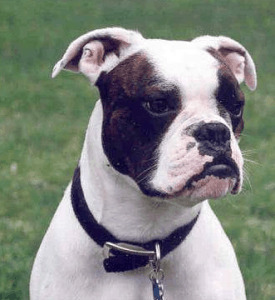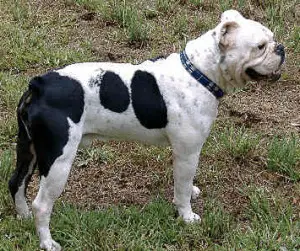 The Valley Bulldog is a designer bulldog which is a taller version of the English Bulldog and a shorter version of the Boxer dog. It is considered to be a rare breed and it is the result of the cross-breeding between the Boxer and the English Bulldog.
The Valley Bulldog is a designer bulldog which is a taller version of the English Bulldog and a shorter version of the Boxer dog. It is considered to be a rare breed and it is the result of the cross-breeding between the Boxer and the English Bulldog.
Sometimes the Valley Bulldog is often referred to as the Bull-Boxer.
Breeders originally started to crossbreed these dogs to get a strong athletic dog with a calm temperament of the Boxer and the Bulldog’s bravery.
This breed is very intelligent, so it will make training your dog commands and tricks incredibly easy.
Valley Bulldog History
The Valley Bulldog as a breed does not have a long history, and it is thought to have originally originated from the AnnapolisValley in Nova Scotia, Canada, hence their names the ‘Valley’ bulldog.
Like we have said, this breed doesn’t have a long history as they were first seen in the 1900s. It has been said this breed was developed to produce a dog with great athleticism, self-confidence, and a great companion.
Also, when you breed two purebred breeds together, you get a mixed breed with a better genetic makeup in the way of health. You can breed out some underlying health conditions.
Valley Bulldog Temperament
If the Valley Bulldog is socialized properly, it has an excellent and loving temperament. It is known for its incredibly friendly and gentle nature with people, especially children, and even other animals – a trait it inherits from its Boxer parentage.
Quite often, these dogs can be quite unpredictable with their behavior, and they can go from being sweet and calm to silly and playful in a matter of minutes, which is what makes these dogs so lovable.
The Valley Bulldog is an intelligent breed and learns easily. Additionally, this dog is very obedient, and because it is so willing to please its owners, it will go above and beyond, making training them very easy.
The Valley Bulldog has an acute sense of hearing, and any slight unfamiliar noise that is heard, it will bark.
Sometimes they will bark at nothing, and firm training needs to ensure that the dog will bark as little as possible. It makes a great watchdog as it will alert the owners to anything unfamiliar.
Valley Bulldog Appearance
You can get a variety of looks from this mixed breed as it will all depend on which traits your dog takes from which parent.
Like most Bulldogs, the Valley Bulldog has a muscular body and a strong build with a broad head and thick neck.
Additionally, it is also noticeably broad across its shoulders and chest. Valley Bulldogs are also known for their strong jaws and teeth with an under-bite.
The ears of this mixed breed will typically be short and slightly folded forward.
The tail is usually small already, and most breeders will actually dock the tail as that is the traditional way with the Boer parent.
They come in a variety of colors, including white, brindle, black, tan, red, or fawn.
Valley Bulldog Coat
The coat of the Valley Bulldog should be very short and fine. It will be very smooth to the touch.
The coat of the Valley Bulldog is not hypoallergenic or allergy-friendly; this dog will shed, but the hair is, of course, shorter and smaller to see.
You will have an easier time grooming this dog breed.
What Colors Do They Come In?
There are only a few colors that the Valley Bulldog can possibly come in and those are:
- Red
- Brindle
- White
- Fawn
- Brown
This breed can however, have various nose and eye colors. Here are the nose colors:
- Black
- Brown
- Blue
Eye colors that are possible:
- Blue
- Brown
- Amber
- Hazel
Valley Bulldog Size
 This stocky dog measures approximately 12-25 inches (31-64cm) in height and weighs between 50-125lbs (23-57kg).
This stocky dog measures approximately 12-25 inches (31-64cm) in height and weighs between 50-125lbs (23-57kg).
As you can see, this is between a medium and large size dog breed.
Valley Bulldog Health Problems
This dog is known for its excess skin and folds. It is very important to keep these areas in between the folds clean and dry as if they are not cleaned properly; they are prone to skin irritations, infections, and allergies.
The Valley Bulldog, like most Bulldogs, tends to not be able to control their intake of food and will eat any kind of food no matter what the amount is.
This will make the dog put on weight easily. Bulldogs typically have breathing problems due to the short necks and excess skin folds, and if the dog is overweight, it can be even more serious.
The Bulldog is also known for the look of the smashed in face, so this breed can have breathing difficulties,
This is just how they are born. They typically can get all the air they need, but you can consult a veterinarian if you are ever concerned.
Life Expectancy of a Valley Bulldog
This dog breed doesn’t have as long of a life expectancy as other combined breeds.
The Valley Bulldog can live between eight and twelve years. Of course, every dog is different; some may live long while some may live longer.
If you ever need expert advice, you can consult your local veterinarian.
Living Conditions
The Valley Bulldog is not a particularly large breed, and therefore it does not require a lot of space inside the house.
Keeping this dog inside an apartment or condo is fine as long as it gets exercised regularly as they tend to become active indoors.
These dogs do not deal with excessive heat too well, and therefore it is better to keep them in air-conditioned rooms.
Valley Bulldog Exercise
The Valley Bulldog is a muscular dog and likes to exercise and spend time outdoors. It is a dog that needs exercise daily because they are part Boxer; they do have an athletic tendency and like to run.
It has great speed, and this dog needs a large open park where it can run freely chasing Frisbees, sticks, or other animals to get its full amount of exercise.
This dog breed needs around 60 minutes of exercise a day. This can be broken up into multiple sessions throughout the day.
If you have a fenced-in yard, that would be a good way to get your dog outside in the fresh air, playing, and getting some exercise.
Valley Bulldog Feeding
As you already know, this is a large dog breed, so it will need a lot of food to sustain your dog and keep your dogs energy up throughout the day.
Three cups of high-quality dog food broken up into meals such as breakfast, lunch, and dinner should be perfect for the Valley Bulldog.
You will want a dog food that has a great deal of protein for this large dog breed. As well as a balance of carbs, vegetables, and fats.
You will want your dog food to have a good quality food that has a major source of real protein in the first few ingredients, such as chicken, beef, or duck.
 Valley Bulldog Grooming
Valley Bulldog Grooming
The Valley Bulldog has a very short soft coat that is easy to maintain, and it only needs brushing on a weekly basis with a soft-bristled brush.
However, it is necessary to wipe down the dog with a damp cloth or towel, especially in between the folds of the skin, to clean the sweat.
The tail area and the genital area of a female are areas that need special attention, and without care, they are prone to infection if dirty.
Additionally, this dog has sensitive skin, so it should be bathed only when needed with hypoallergenic shampoo and dried properly with a towel.
Of course, remember to brush your dog’s teeth as needed and to trim your dog’s nails when they get too long.
With an active dog breed like this, they should be wearing down their nails naturally, but if your dog isn’t, you will need to trim them down yourself.
Valley Bulldog Training
This is another intelligent dog breed, so there shouldn’t be a problem training this dog breed. If you have a male Valley Bulldog, you will want to have a strong authority to effectively train your Valley Bulldog.
Start training your dog on easy things like simple commands and tricks. You can work your way up to harder ones after your dog has mastered the simpler ones.
Always give your dog positive reinforcement when training as it creates a positive experience for your dog.
You can do this with treats as well as words of affirmation.
Valley Bulldog Puppies
Valley Bulldogs are one of the more affordable mixed dog breeds. You should expect to spend around $500 to $2,000 for a Valley Bulldog puppy.
Of course, the price will vary, and all depend on the breeder. Overall it is a very affordable price range for a dog.
Make sure you look for a breeder that you can trust. You don’t want to just choose any breeder; you want one that will let your visit the kennel, show health papers, etc.
Remember, puppies and dogs in general cost a lot over time so just remember that it is not just the cost of the puppy but more associated in the future with food and vet checkups.
Valley Bulldog Litter Size
A female Valley Bulldog can have between 6-10 puppies in a single litter. This dog breed can only have one litter per year.
Any more litters than just one per female a year truly isn’t very healthy for the female dog.
The gestation period for a female Valley Bulldog is between 60 and 64 days.
Suitability
This dog is suitable for families and even those with small houses. It makes a great companion for anyone and will suit most families who could exercise it on a daily basis.
Close relatives of the Valley Bulldog
Here are a few breeds that are similar to the Valley Bulldog:
- English Bulldog
- Boxer
- Alapaha Blue Blood Bulldog

